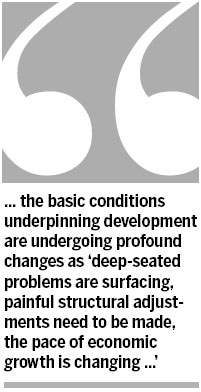Reforms at a 'critical juncture'
Updated: 2014-03-17 07:56
By Dan Steinbock (China Daily USA)
|
|||||||||
The increasingly volatile global markets set the scene for Premier Li Keqiang's press conference on the last day of the National People's Congress annual session. Li reiterated what he had already said in the Government Work Report: China has reached a "critical juncture where our path upward is particularly steep".
As Li sees it, the basic conditions underpinning development are undergoing profound changes as "deep-seated problems are surfacing, painful structural adjustments need to be made, the pace of economic growth is changing, and downward pressure on the economy remains great".
That's the challenging part of the story. But there is another side to it as well. China continues to have the foundations-including potential for industrialization and urbanization-to maintain a significant rate of growth for some time to come.
In the nearly two-hour long press conference by Li, every fourth question was on China's economic development and reforms. Li said China will seek sustained growth through reforms and deleveraging. China's growth target will remain about 7.5 percent this year, he said, but it will be "flexible".
As the policy focus is shifting from sheer growth to employment and increasing people's incomes, economic targets are now more malleable. The goal is sustainable growth, which will benefit the people. But the government has to control excessive leverage and financial risk.
Li hopes to create 10 million urban jobs this year and keep the urban unemployment rate at 4.6 percent. Amid the country's urbanization drive, the government built 5.4 million subsidized housing units last year. This year, it will build 7 million more. Increasing social financing means budget deficit, but the government hopes to keep it at 2.1 percent of the GDP. With its austerity drive, the government seeks to lead by example by drastically reducing its expenditure.

China's industrial structure is undergoing a deep change. For the first time, the service sector has surpassed the industrial sector. "We will press ahead with fiscal, tax and financial reforms," Li said.
The key tasks for 2014 include market-driven reforms to boost domestic demand as the engine of growth, modernization of agriculture, people-centric urbanization, and improvement in the education and healthcare systems.
Until the recent past, China was seen as the "world factory". But it is gradually morphing into a global research and development hub. Li hopes to accelerate this shift by allocating 2.2 percent of the GDP for R&D.
The premier had to overcome strong, entrenched interests to launch the Shanghai Free Trade Zone, which has paved the way for comparable FTZs in other Chinese cities and provinces in the coming years. But to deepen reform-and follow market rules-State-owned enterprises should be opened to private investment.
At the press conference, Li's remarks on government debt which he said was in control, were the most anticipated. To minimize the risk, however, government debt and shadow banking will be more closely scrutinized. Some recent shadow banking-related incidents, including the failure of a trust product and the subsequent murky bailout, have left international markets jittery.
The problems can be traced to the global financial crisis, which China overcame with the support of a 4 trillion yuan stimulus package. Although the government achieved many of its objectives, money from the stimulus package was also poured into local government funds and State-owned enterprises.
That led to overcapacity in several sectors, particularly shipbuilding, metals and mining, building materials, and solar equipment. The list also includes weaker borrowers in the property sectors, especially those with high exposure to trust funding.
According to the National Audit Office, local government debt by mid-2013 had increased to $2.9 trillion, which accounts for 31 percent of GDP. However, as the leading international ratings agency Standard & Poor's said recently, it does not see a credit crisis within China as a baseline scenario. "We are not in the panic camp," as S&P put it.
In accordance with international (Basel III) requirements, Chinese authorities now expect the minimum capital adequacy ratio of banks to increase to 10.5 percent, while larger banks must meet the 11.5 percent requirement. The authorities are aware of the challenges they face. They know that the longer the misaligned incentives in the shadow banking sector remain unaddressed, the larger the distortions will become.
Nonetheless, investor concerns have been fueled by the inability of projects to generate adequate cash flow to repay debts, which has led to defaults involving financial products-from wealth management and trust products to bonds.
"It is indeed difficult to avoid a few default cases," Li said. "We must tighten monitoring to prevent regional and systemic financial risks." Since the government is now willing to compel borrowers to abide by market rules, the financial reforms can foster a mature credit risk culture.
In the short term, it will mean some pain and associated volatility. In the medium term, it is vital to lay a foundation for a more sustainable and well-developed capital market in China. Delays are not an option. A thriving but robust financial system is critical to the nascent social model, which, in turn, is vital to shift growth toward consumption.
The author is research director of International Business at India China and America Institute (USA) and Visiting Fellow at Shanghai Institutes for International Studies (China) and the EU Centre (Singapore).
(China Daily USA 03/17/2014 page12)

 Crimeans start celebrating pending referendum outcome
Crimeans start celebrating pending referendum outcome
 European universities growing in popularity among students
European universities growing in popularity among students
 Muslims in Malaysia pray for missing plane
Muslims in Malaysia pray for missing plane
 Ukraine's Crimea kicks off referendum
Ukraine's Crimea kicks off referendum
 Travel-tourism forum advises US to 'loosen' visa requirements
Travel-tourism forum advises US to 'loosen' visa requirements
 Nose gear on plane collapses at Philly airport
Nose gear on plane collapses at Philly airport
 US Black Sea naval drills start near Crimea
US Black Sea naval drills start near Crimea
 Cooperation at the heart of win-win, Li tells world
Cooperation at the heart of win-win, Li tells world
Most Viewed
Editor's Picks

|

|

|

|

|

|
Today's Top News
US not to recognize Crimean referendum
Missing jet pilots' motive probed
Alibaba opts for IPO in US
Stronger cop presence urged after knife attacks
Crimea kicks off referendum
Kindergarten closed for drug use
Xi stresses building of strong army
Dispute triggered knife attack in C China
US Weekly

|

|







